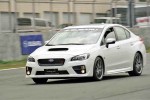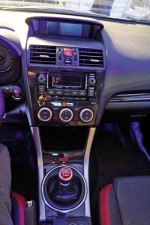
MOTOR Image bosses Glenn Tan and Mike Luyun are joined by Asia’s Next Top Model beauties at the Clark Speedway regional launch
Subaru unveiled the all-new Impreza WRX and STI models to the very excited and enthusiastic Asean Media, dealer principals and special guests hot on the heels of its public unveiling at the recently concluded Manila International Autoshow.
Led by Motor Image’s Group chief executive and Tan Chong Motors executive director Glenn Tan and members of the engineering and research division of Fuji Heavy Industries, Subaru’s parent company, the whole day was filled with driving the latest Subaru models on different sections of the world-class Clark International Speedway. In total, the event received guests from nine countries including the Philippines, Vietnam, Cambodia, China, Taiwan, Thailand, Singapore, Malaysia and Indonesia. Many were first-time guests and were impressed by the Philippines.
The all-new Subaru Impreza WRX and STI models were benchmarked against Porsche’s highly-acclaimed 911 Carrera S sports car. Fuji Heavy Industries (FHI) engineers said that Porsche’s iconic 911 shares many traits with the WRX and STI models: boxer engines, more than two-person seating, a premium on fine engineering detail and a focus on sheer driving performance and pleasure, with very good balance on power, control and everyday usability.
Hence, FHI focused on improving the overall absolute balance of power and control to deliver elevated driving performance that is easier and safer for a broader range of drivers in a lot of weather and road conditions. The Top 3 dynamic handling priorities were improved steering response, which was achieved by stiffening the front chassis frame rails by improved welding techniques and using higher carbon-steel, adjustments to suspension kinematics and angles; more rear tire grip to allow the chassis to pivot effectively and maximize control on corner exit, allowing you to floor the throttle sooner without risk of under or over-steer and a flat ride which would allow greater cornering speeds and increased stability.
Former multiple World Rally champion Tommi Makinen, who ended his career with Subaru, greatly helped tune the suspension settings to provide what the champion describes as the perfect balance for control, confidence and refinement on varying driving conditions.
Grown up
Visually, the WRX and STI have grown up. Gone are the bulbous, aftermarket-looking fender flares, replaced by sleeker, leaner sculpting to swallow the massive 18×8.5-inch wheels of the STI and 17×8-inch wheels of the WRX. Both are still significantly wider than the regular Impreza sedan and, for our market, the STI comes with exotic-looking forged aluminum BBS wheels, behind which hide large four-piston front and two-piston rear Brembo brake calipers. In a break from recent tradition, the STI and WRX once again share the same body panels all throughout, much like the original GC8-body classic Impreza WRX and STI of the 1990s.
Underneath the hood is where the biggest differences lie: The STI makes do with the current-generation EJ257 that has powered the two previous STI sedans. It is a 2.5-liter, DOHC 16-valve mill equipped with a massive turbocharger and top-mount intercooler for propulsion. Peak power remains at 300 horsepower and 410 Newton-meters of torque, feeding Subaru’s Symmetrical All-Wheel Drive system via a slick-shifting, six-speed manual transmission with improved throws.
The big news is the WRX comes with the newer FA20 direct-injection, turbocharged gasoline engine that has been tweaked to deliver 268 HP and 350 Nm of torque despite having 500 cc less displacement than the EJ257 engine. This is the same engine that powers the Forester XT as well as its nonturbo guises, the XV and Impreza sedans. Locally, we will only get the WRX with Subaru’s Sport Lineartronic Heavy Duty CVT transmission to help provide a balance of response and efficiency. Symmetrical All-Wheel Drive is of course still standard on the WRX.
Inside, the legroom has grown larger thanks to an increase in wheelbase versus the previous model. The interior is also more refined. It utilizes much more premium-feeling materials and feels more upmarket as Subaru continues to chase the mainstream market without abandoning its core enthusiast clientele.
Also, both the STI and WRX get a flat-bottom steering wheel with red stitching and highlights, carbon-fiber trim on the dashboard and door sidings matched with contrasting silver panels. The STI gets much more supportive sports seats that hold you better on Clark’s infamous corkscrew section. While the WRX’s seats, though just as supportive as the STI, offers more comfort on long drives.
Out on track, international driving legend Russ Swift took us on a slalom course to see the improved stability of the all-new STI: It is able to take the slalom as much as 10-15 kph faster than its predecessor and with much less chassis roll, allowing drivers to corner faster, much more consistently, and crucially, much more confidently. Even Swift was impressed by the STI’s flat ride and improved rear tire grip afforded by the firmer suspension. Thankfully, ride quality doesn’t suffer thanks to the stiffer chassis.
Added performance
At the very end of the slalom is a tight, 180-degree U-turn that highlighted the added performance brought by the STI’s torque-vectoring control: It brakes the inside rear wheel, which in conjunction with improved rear tire grip allowed the STI’s rear end to pivot effectively, much like how baseball players and golfers utilize their forward knees to give an extra push, as demonstrated by the STI and WRX product presentation earlier.
On the road course, the STI and WRX are impressive: The STI corners confidently despite decreasing radius and off-camber corners, and transitions well from quick left to quick right chicanes while accelerating or braking hard. Heel-toe downshifts are a real pleasure and there’s an urgency in the STI’s throttle that seems all but to quench turbo lag. The torque vectoring control is something to get used to, however: Initially it feels like the rears will swing out wide as the inner rear wheel is braked, but manhandle the steering and throttle a bit and the STI rotates beautifully and controllably, just like how all rally replicas are supposed to be driven. On the other hand, the WRX lacks the razor’s edge of the STI but brings with it its own brand of confidence and control with an added degree of comfort for long drives.
Both cars have a noticeably firmer, more refined interior that quells a lot of underchassis noise. But as a bonus, you can hear the beautiful induction and exhaust noise of both the WRX and STI much more clearly. The STI in particular had a very pronounced mechanical noise and muscular, nonfabricated exhaust note at wide-open throttle which made everyone present adore it even more.
Aside from driving the WRX and STI, a free-style section on Clark’s short track was also set-up, which allowed drivers to sample the BRZ sports car and Forester SUV, plus a simulated offroad course which demonstrated the X-Mode integrated Vehicle Dynamics Control system of the Forester.
Motor Image Pilipinas’ sales forecast for the Asean Region will be 18,000 Subaru vehicles sold for 2014, with the Philippines contributing a substantial 4,000 units for this year alone, an increase of over 30 percent from last year’s 3,000-unit target that Motor Image narrowly missed by a slim 20 units. With the Philippine automotive industry on a high, we can expect to see more boxer-engined cars on the road.
- MOTOR Image bosses Glenn Tan and Mike Luyun are joined by Asia’s Next Top Model beauties at the Clark Speedway regional launch
- THE STI model was benchmarked against Porsche’s highly-acclaimed 911 Carrera S sports car.
- BBS forged wheels and Brembo brakes
- STI EJ257 engine
- STI controls
- STI puts premium on sheer driving performance and pleasure
Disclaimer: The comments uploaded on this site do not necessarily represent or reflect the views of management and owner of Cebudailynews. We reserve the right to exclude comments that we deem to be inconsistent with our editorial standards.














